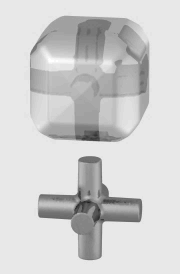Computer animation is the process used for generating animated images by using computer graphics. The more general termcomputer generated imagery encompasses both static scenes and dynamic images, while computer animation only refers to moving images.
Modern computer animation usually uses 3D computer graphics, although 2D computer graphics are still used for stylistic, low bandwidth, and faster real-time renderings. Sometimes the target of the animation is the computer itself, but sometimes the target is another medium, such as film.
 Computer animation is essentially a digital successor to the stop motion techniques used in traditional animation with 3D models and frame-by-frame animation of 2D illustrations. Computer generated animations are more controllable than other more physically based processes, such as constructing miniatures for effects shots or hiring extras for crowd scenes, and because it allows the creation of images that would not be feasible using any other technology. It can also allow a single graphic artist to produce such content without the use of actors, expensive set pieces, or props.
Computer animation is essentially a digital successor to the stop motion techniques used in traditional animation with 3D models and frame-by-frame animation of 2D illustrations. Computer generated animations are more controllable than other more physically based processes, such as constructing miniatures for effects shots or hiring extras for crowd scenes, and because it allows the creation of images that would not be feasible using any other technology. It can also allow a single graphic artist to produce such content without the use of actors, expensive set pieces, or props.
To create the illusion of movement, an image is displayed on the computer screen and repeatedly replaced by a new image that is similar to it, but advanced slightly in time (usually at a rate of 24 or 30 frames/second). This technique is identical to how the illusion of movement is achieved with television and motion pictures.
For 3D animations, objects (models) are built on the computer monitor (modeled) and 3D figures are rigged with a virtual skeleton. For 2D figure animations, separate objects (illustrations) and separate transparent layers are used, with or without a virtual skeleton. Then the limbs, eyes, mouth, clothes, etc. of the figure are moved by the animator onkey frames. The differences in appearance between key frames are automatically calculated by the computer in a process known as tweening or morphing. Finally, the animation is rendered.
For 3D animations, all frames must be rendered after modeling is complete. For 2D vector animations, the rendering process is the key frame illustration process, while tweened frames are rendered as needed. For pre-recorded presentations, the rendered frames are transferred to a different format or medium such as film or digital video. The frames may also be rendered in real time as they are presented to the end-user audience. Low bandwidth animations transmitted via the internet (e.g. 2D Flash, X3D) often use software on the end-users computer to render in real time as an alternative to streaming or pre-loaded high bandwidth animations.
A simple example
The screen is blanked to a background color, such as black. Then, a goat is drawn on the right of the screen. Next, the screen is blanked, but the goat is re-drawn or duplicated slightly to the left of its original position. This process is repeated, each time moving the goat a bit to the left. If this process is repeated fast enough, the goat will appear to move smoothly to the left. This basic procedure is used for all moving pictures in films and television.
The moving goat is an example of shifting the location of an object. More complex transformations of object properties such as size, shape, lighting effects often require calculations and computer rendering instead of simple re-drawing or duplication.
Explanation
To trick the eye and brain into thinking they are seeing a smoothly moving object, the pictures should be drawn at around 12 frames per second (frame/s) or faster (a frame is one complete image). With rates above 70 frames/s no improvement in realism or smoothness is perceivable due to the way the eye and brain process images. At rates below 12 frame/s most people can detect jerkiness associated with the drawing of new images which detracts from the illusion of realistic movement. Conventional hand-drawn cartoon animation often uses 15 frames/s in order to save on the number of drawings needed, but this is usually accepted because of the stylized nature of cartoons. Because it produces more realistic imagery computer animation demands higher frame rates to reinforce this realism.
Movie film seen in theaters in the United States runs at 24 frames per second, which is sufficient to create the illusion of continuous movement. For high resolution, adapters are used.
Methods of animating virtual characters
 In most 3D computer animation systems, an animator creates a simplified representation of a character's anatomy, analogous to a skeleton or stick figure. The position of each segment of the skeletal model is defined by animation variables, or Avars. In human and animal characters, many parts of the skeletal model correspond to actual bones, but skeletal animation is also used to animate other things, such as facial features (though other methods for facial animation exist). The character "Woody" in Toy Story, for example, uses 700 Avars, including 100 Avars in the face. The computer does not usually render the skeletal model directly (it is invisible), but uses the skeletal model to compute the exact position and orientation of the character, which is eventually rendered into an image. Thus by changing the values of Avars over time, the animator creates motion by making the character move from frame to frame.
In most 3D computer animation systems, an animator creates a simplified representation of a character's anatomy, analogous to a skeleton or stick figure. The position of each segment of the skeletal model is defined by animation variables, or Avars. In human and animal characters, many parts of the skeletal model correspond to actual bones, but skeletal animation is also used to animate other things, such as facial features (though other methods for facial animation exist). The character "Woody" in Toy Story, for example, uses 700 Avars, including 100 Avars in the face. The computer does not usually render the skeletal model directly (it is invisible), but uses the skeletal model to compute the exact position and orientation of the character, which is eventually rendered into an image. Thus by changing the values of Avars over time, the animator creates motion by making the character move from frame to frame.
There are several methods for generating the Avar values to obtain realistic motion. Traditionally, animators manipulate the Avars directly. Rather than set Avars for every frame, they usually set Avars at strategic points (frames) in time and let the computer interpolate or 'tween' between them, a process called keyframing. Keyframing puts control in the hands of the animator, and has roots in hand-drawn traditional animation.
In contrast, a newer method called motion capture makes use of live action. When computer animation is driven by motion capture, a real performer acts out the scene as if they were the character to be animated. His or her motion is recorded to a computer using video cameras and markers, and that performance is then applied to the animated character.
Each method has its advantages, and as of 2007, games and films are using either or both of these methods in productions. Keyframe animation can produce motions that would be difficult or impossible to act out, while motion capture can reproduce the subtleties of a particular actor. For example, in the 2006 film Pirates of the Caribbean: Dead Man's Chest, actor Bill Nighy provided the performance for the character Davy Jones. Even though Nighy himself doesn't appear in the film, the movie benefited from his performance by recording the nuances of his body language, posture, facial expressions, etc. Thus motion capture is appropriate in situations where believable, realistic behavior and action is required, but the types of characters required exceed what can be done through conventional costuming.
Computer animation development equipment
Computer animation can be created with a computer and animation software. Some impressive animation can be achieved even with basic programs; however, therendering can take a lot of time on an ordinary home computer. Because of this, video game animators tend to use low resolution, low polygon count renders, such that the graphics can be rendered in real time on a home computer. Photorealistic animation would be impractical in this context.
Professional animators of movies, television, and video sequences on computer games make photorealistic animation with high detail. This level of quality for movie animation would take tens to hundreds of years to create on a home computer. Many powerful workstation computers are used instead. Graphics workstation computers use two to four processors, and thus are a lot more powerful than a home computer, and are specialized for rendering.
Detailed examples and pseudocode
In 2D computer animation, moving objects are often referred to as “sprites.” A sprite is an image that has a location associated with it. The location of the sprite is changed slightly, between each displayed frame, to make the sprite appear to move. The following pseudocode makes a sprite move from left to right:
var int x := 0, y := screenHeight / 2; while x < screenWidth drawBackground() drawSpriteAtXY (x, y) // draw on top of the background x := x + 5 // move to the right
Computer animation uses different techniques to produce animations. Most frequently, sophisticated mathematics is used to manipulate complex three dimensional polygons, apply “textures”, lighting and other effects to the polygons and finally rendering the complete image. A sophisticated graphical user interface may be used to create the animation and arrange its choreography. Another technique called constructive solid geometry defines objects by conducting boolean operations on regular shapes, and has the advantage that animations may be accurately produced at any resolution.
Let's step through the rendering of a simple image of a room with flat wood walls with a grey pyramid in the center of the room. The pyramid will have a spotlight shining on it. Each wall, the floor and the ceiling is a simple polygon, in this case, a rectangle. Each corner of the rectangles is defined by three values referred to as X, Y and Z. X is how far left and right the point is. Y is how far up and down the point is, and Z is far in and out of the screen the point is. The wall nearest us would be defined by four points: (in the order x, y, z). Below is a representation of how the wall is defined


ไม่มีความคิดเห็น:
แสดงความคิดเห็น